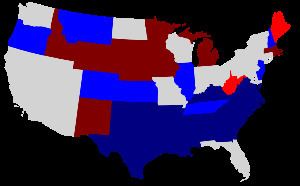January 16, 1912 –
January 29, 1913 1914 / 1915 → 17 12 4 7 | 43 52 47 45 13 19 | |
 | ||
In the United States Senate elections of 1912 and 1913, Democrats gained control of the Senate from the Republicans. This coincided with Democrat Woodrow Wilson's victory in the presidential election amid a divide in the Republican Party. In the Senate, Joseph M. Dixon and Miles Poindexter defected from the Republican Party and joined Theodore Roosevelt's new Progressive Party. Dixon, however, lost his seat during this election.
Contents
- Before the elections
- Complete list of races
- Special elections during the 62nd Congress
- Races leading to the 63rd Congress
- Elections during the 63rd Congress
- Virginia
- References
Some states elected their Senators directly even before passage of the 17th Amendment in 1913. Oregon pioneered direct election and experimented with different measures over several years until it succeeded in 1907. Soon after, Nebraska followed suit and laid the foundation for other states to adopt measures reflecting the people's will. By 1912, as many as 29 states elected senators either as nominees of their party's primary or in conjunction with a general election.
This was the first time in 20 years that the Democrats won a majority in the Senate.
Before the elections
After the March 1912 elections to elect Senators from the new states of New Mexico and Arizona.
Complete list of races
Bold states link to specific election articles.
Special elections during the 62nd Congress
In these special elections, the winners were seated in the 62nd Congress during 1912 or before March 4, 1913; ordered by election date.
In this early election, the winner was seated in the 64th Congress, starting March 4, 1915.
Races leading to the 63rd Congress
In these general elections, the winner was seated on March 4, 1913; ordered by state.
All of the elections involved the Class 2 seats.
Elections during the 63rd Congress
In these elections (some special, some merely late), the winners were seated in 1913 after March 4; ordered by election date.
Virginia
Virginia held non-binding primaries in September 1911 for the class 2 seat held by Democrat Thomas S. Martin, who was running for re-election, and the class 1 seat held by Democrat Claude Swanson, who had been appointed to fill a vacancy. Claude A. Swanson won the Class 1 Democratic primary for the term ending in 1917 with 67,495 votes over Carter Glass's 28,757 votes. Thomas S. Martin won the Class 2 Democratic primary for the term ending in 1919, receiving 57,120 votes to 25,005 for William Atkinson Jones. On January 24, 1912, the Virginia General Assembly unanimously elected both Swanson and Martin, thus ratifying the results of the primary.
